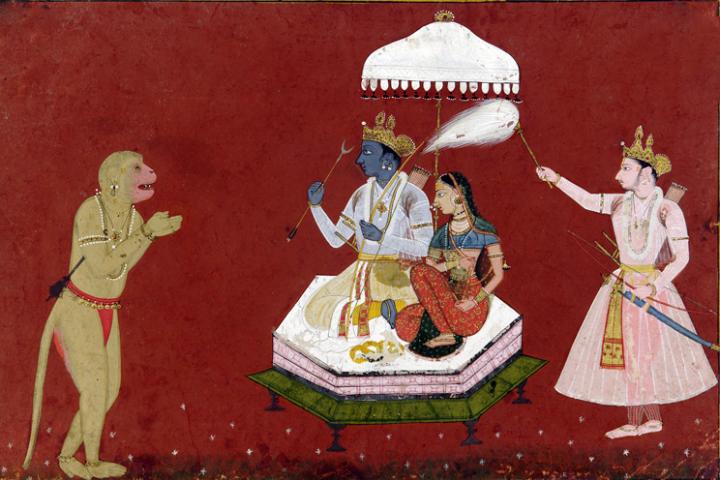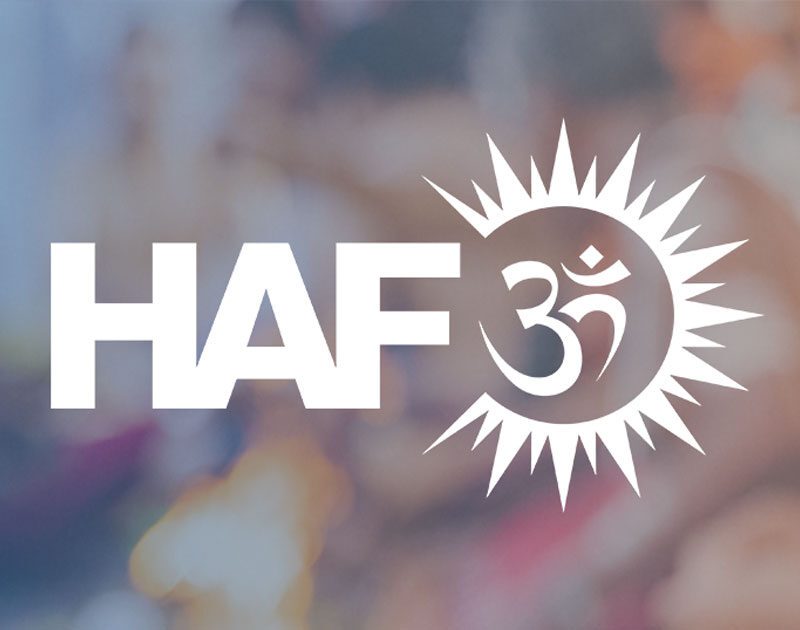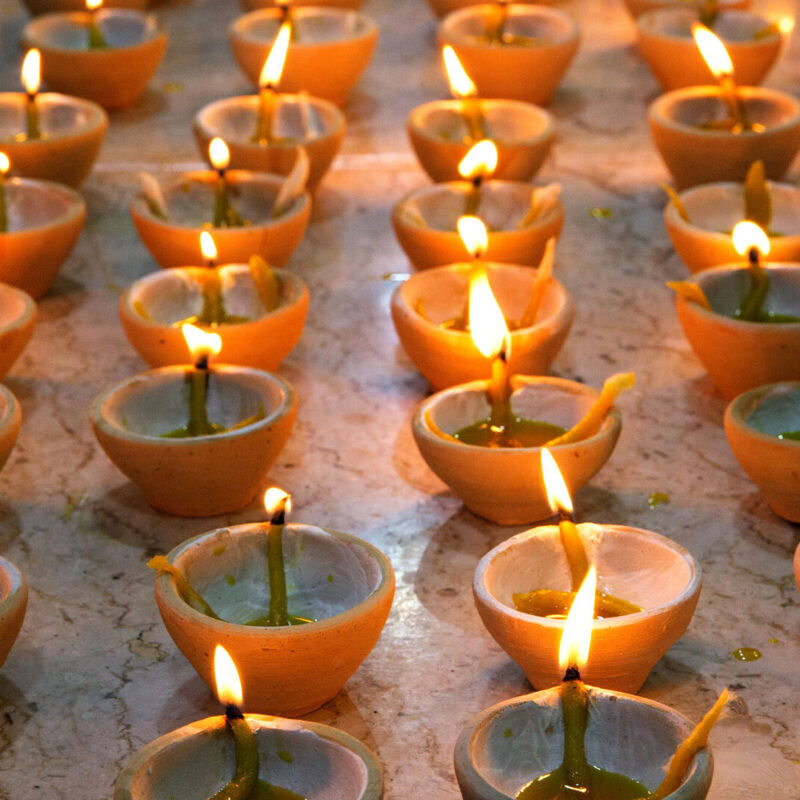
Dharmarath is a combination of two words: Dharma (eternal and inherent nature of reality; duty, virtue, morality and what is ethical in this world) and rath (a chariot).
Dharmarath is a metaphor of the chariot which outlines the principle virtues that enable an individual to win glory by overcoming all the worldly obstacles but in the absence of any practical means.
Dharmarath is an extract from Ramcharitmanas written by Saint Tulsidas. (Lanka Kand, Doha number.80 a-b, Chaupai line numbers 1-11 preceding this Doha).
In the furious battle between Lord Rama and Ravana (the demon king) when Vibhishana (Ravana’s younger brother and a devotee of Lord Rama) observed that Lord Rama was on foot and Ravana was on a powerful and well-equipped war chariot, he got doubtful of Lord Rama’s victory. He then conveyed his fears to Lord Rama, on which Lord preached him about the symbolic Chariot that is required to win not only in the battlefield but also in all other odds of life.
The chariot, Lord Rama narrates here, is in fact the heavenly and outstanding qualities and acclaimed virtues that an individual needs to instill within to win against any odds and be victorious. The virtues and attributes are equated with the chariot, and once an individual rides such a chariot, his victory is certain. Similarly, the challenges a human being faces in his day-to-day life are beyond his control, but if he practices these principles, he will come out victorious.
Chaupai 1
Ravana rathi biratha raghubira, dekhi bibhisana bhaya’u adhira. 1.
Adhik priti man bha sandeha, bandi carana kaha sahita saneha. 2.
The moment in the battlefield when Vibhishana noticed Lord Rama on foot and Ravana on a well-equipped chariot, which would give Ravana(demon king) an edge in the battlefield, he became worried and impatient. This reaction of Vibhishana was out of his love and concern for Lord Rama. He bowed before Lord Rama and expressed his fear. Lord Rama here alluded the battle an individual fights in his day-to-day life and the chariot he rides are the virtues and principles he must instill within to win against all odds.
Natha na ratha nahim tana pada trana, kehi bidhi jitaba bir balvana. 3.
Sunahu sakha kaha kripanidhana, jehim jaya hoi so syandana ana. 4.
Vibhishana said, “My Lord you don’t have a chariot, nor do you have anything special to protect your feet. So, hey Lord, how will you win over this formidable enemy (Ravana).”
Lord Rama who is full of love and compassion, consoles Vibhishana and describes how the real chariot which brings victory is different from the one that Ravana possessed.
Lord Rama teaches Vibhishana about the principles and virtues required to win any worldly war and explains how dharma acts like an impenetrable body armor. Lord Rama uses this opportunity to teach not only Vibhishana but the whole humanity what it takes to ride a Dharmarath.
Sauraj dhiraja tehi ratha caka, satya sila driha dhvaja pataka. 5.
Valor and bravery (sauraj) and patience and resilience (dhiraja) are the two symbolic wheels of the chariot and truth (satya), honesty and good character (sheel) and individual’s conduct are the two flying flags of the Dharmarath.
If we inculcate virtues of politeness, courteousness, and humility in our conduct we can win over all the obstacles in our life. A person possessing the virtues of truth and good character is always liked and respected.
Like the flag mounted on the top of a chariot is visible even when the chariot is not from a distance in the battlefield, in the same way a person with the virtues of truth and good character gets glory in all parts of the world and his name spreads even to that part of the world where he has never been to. As in the battlefield the fall of flag signifies defeat, same way if a man compromises with the virtues of truth and good character, he is considered as a defeated human being.
Bal bibeka dama parahita ghore, chama kripa samata raju Jore. 6.
The four incredible horses of the Dharmarath are strength (bal), wisdom and rationality (bibek), self-restraint and control (dam), and the desire to do good to others. The reins of these horses are the three virtues namely, forgiveness (kshama), compassion (kripa), and equality (samta).
If any individual has these qualities inculcate in him, his life’s chariot runs smoothly without any problem. An individual with self-control and self-restraint can control the reins in a most dignified manner. Working towards others’ well-being and promoting peace and fulfillment in life encourages benevolence and fellowship. It is a common belief that success brings along with it pride and arrogance, but if a person has these three virtues by his side, he remains humble and is surrounded by noble thoughts throughout his life.
Isa bhajanu sarathi sujana, birati carma santosh kripana. 7.
In this phrase Lord Rama describes who the charioteer is and what qualities does it take to be a victorious one.
Devotion and faith in God act like a successful charioteer. The virtue of renunciation (virti) is a strong shield and contentment (santosh) is the symbolic sword of this Dharamrath.
Individuals who have absolute faith in God and leaves all in his hands, never get disappointed. The Almighty nurtures his devotees and no force of nature can disturb them. A person who has inculcated the art of detachment from the worldly desires is always fearless in the times of hardships. When one leaves his destiny in Gods’ hands, he is at peace because he is always taken care of.
Dana parasu budhi sakti pracanda, bar bigyana kathina kodanda. 8.
In this phrase Lord Rama explains how the attribute of being charitable (daan) and contributing for a noble cause acts like a powerful battle-axe. The virtue of charity can turn a man’s enemy into his admirer. Hence, man should give donations and do charity work to the best of his capabilities.
He further adds how intelligence, critical thinking, and a logical mindset act like a sharp spear. A wise man can not only control his present but can plan his future as well.
He further adds how in-depth understanding of any situation and ability to think logically are the tough bows. A person’s intellect allows him to take charge of adverse situation and come out of it with flying colors. But intellect and insightful mind go hand in hand, as one needs deep knowledge of a subject to make use of his intellect.
Amala acala mana trona samana, sama jama niyama silimukha nana. 9.
The quiver of the chariot are clean, pure (amal), steady (achal) mind and heart. The different arrows in the quiver are controlled mind (sham), self-control (yam), observance of duties, pledge, and rituals (niyam). These qualities lays a victorious path in all fields of life. A steady mind can always focus and think clearly, which makes all his efforts bear fruits.
Kavaca abheda bipra guru puja, ehi sama biyaja upaya na duja. 10.
In this phrase Lord Rama narrates the symbolic qualities of the impenetrable body armor.
Adoring and having devotion and faith in elderly (vipra), spiritual teacher (guru) acts like an impenetrable body armor. The blessings from the Almighty and saints work as an impassable body armour. There is no other way in the whole universe to win any battle without these practices. Lord Rama narrates about the miracles of divine blessings and what wonders it can do. Blessings can help a physically challenged person climb mountains and cross oceans without a ship. Anything is possible when a person has Gods’ blessings by his side.
Sakha dharamamaya asa ratha jakem, jitana kaham na katahum ripu takem. 11.
Lord Rama addresses Vibhishana as his friend and says that a person who has such a chariot of dharma, becomes indestructible and no opponent can ever conquer him. Lord Rama has outlined in all twenty one virtues which are required to become invincible against all the odds of life.
The virtues namely are; Sauraj, Dhiraja, Satya, Sheel, Bal, Vivek, Dam, Parhit, Kshamaa, Kripaa, Samtaa, Bhajan, Virti, Santosh, Daan, Buddhi, Vigyan, Amal and Achal mana, Sama, Yam, Niyam, and devotion towards brahmins and guru. In fact, Lord Rama possessed all these virtues, which made him invincible.
DOHA : Maha ajaya sansara ripu jiti sakai so bira.
Jakem asa ratha hoi drrha sunahu sakha matidhira. 80(a)
Lord Rama in this doha explains that if an individual inculcates these virtues in his everyday life, he becomes invincible even if the whole world is against him. He addresses Vibhishana as a person with steady and resolute mind and explains that a warrior with this dharma ratha by his side can never be defeated.
DOHA : Suni prabhu bacana bibisana harasi gahe pada kanja.
Ehi misa mohi upadesehu rama kripa sukha punja. 80(b)
When Vibhishana heard these words from Lord Rama, he felt elated and contended and expressed his gratitude. He addressed Lord Rama as an ocean of mercy and compassion, and how fortunate he is to get this wisdom regarding his concerns of the necessity of a chariot in the battle called life.







































